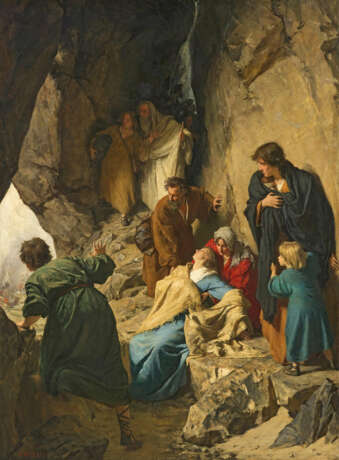ID 1319892
Lot 1323 | Alois Delug. Christians on the Run
Valeur estimée
€ 10 000 – 20 000
1859 Bozen - 1930 Wien
Title:
Christians on the Run.
Date:
Before 1888.
Technique:
Oil on canvas.
Mounting:
Relined.
Measurement:
180 x 134,5cm.
Notation:
Signed lower left: "A. Delug".
Frame:
Framed.
Exhibition:
III. int. art exhibition in the Glaspalast (Glass Palace), Munich 1888, no. 860.
Literature:
Exhib. cat. Bozen 1990: Alois Delug, 1859 - 1930, p. 14, black and white ill. 3, p. 69.
Provenance:
Private ownership, Germany;
French Gallery, England.
The painting Christians on the Run is Alois Delug's final work at Vienna's Academy of Fine Arts. There, the young artist from Bolzano studied under the history and oriental painter Leopold Carl Müller. He was 27 years old when he created this large-format composition, which was so convincing that he was awarded the Academy's Rome Prize and a scholarship for Italy. His two-year stay in Italy was followed by travels through France, Belgium, and Holland before Alois Delug settled in Munich for a few years and then permanently settled in Vienna in 1896. He took up a professorship at the Academy of Fine Arts, becoming an essential reformer of the university system and an influential teacher. Delug was also active in art politics, including as a co-founder of the Vienna Secession in 1897. The roots of Alois Delug's oeuvre lie in naturalistic history painting, with symbolist tendencies being added in the 1890s. Later, he mainly painted portraits; he received many commissions from Austria, Germany, England, and the USA.
In the present painting, Christians on the Run, the young Alois Delug utilises a special artistic trick: The composition is designed so that the viewer appears to be part of the group of people hiding in a cave. Those gathered here have their full attention focused on what is happening outside their hiding place, which can be seen through the cave opening on the left-hand edge of the picture and probably through a gap in the background. The viewer also has to peer over the shoulder of the boy in the green robe to vaguely recognise who is terrifying the group - to the point of fainting: they are invading Huns who are burning and plundering the refugees' villages.
Alois Delug shows the different emotions of the christians in this scene: the defensive fright of the boy in the green robe, the care of the woman in the red dress for the fainting woman in the centre, the protective, standing woman on the right edge of the picture, who is carrying an infant and to whom a frightened child is clinging. Strong light falls through the entrance to the cave and illuminates the scene as far as the bottom right-hand edge of the picture. Alois Delug took up the figure of the fainting woman in the blue dress and the people facing her again two years later in the painting "The Holy Women at the Stations of the Cross".
At art academies, history painting was regarded as the highest of the art disciplines because it uses a historical example to visualise timeless human emotions. Thus, Christians on the Run by Alois Delug is of an oppressive topicality, especially today.
| Artiste: | Alois Delug (1859 - 1930) |
|---|---|
| Technique appliquée: | Huile |
| Catégorie maison de vente aux enchères: | Peintures de maîtres récents |
| Artiste: | Alois Delug (1859 - 1930) |
|---|---|
| Technique appliquée: | Huile |
| Catégorie maison de vente aux enchères: | Peintures de maîtres récents |
| Adresse de l'enchère |
VAN HAM Kunstauktionen GmbH Hitzelerstr. 2 50968 Köln Allemagne | ||||||||||||||
|---|---|---|---|---|---|---|---|---|---|---|---|---|---|---|---|
| Aperçu | |||||||||||||||
| Téléphone | +49 221 92586215 | ||||||||||||||
| Fax | +49 221 92 58 62 4 | ||||||||||||||
| Commission | 32% | ||||||||||||||
| Conditions d'utilisation | Conditions d'utilisation | ||||||||||||||
| Heures d'ouverture | Heures d'ouverture
|






